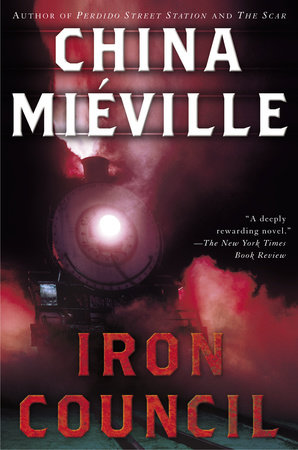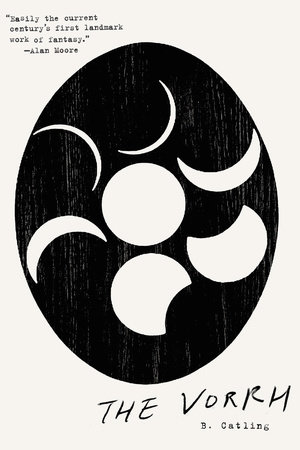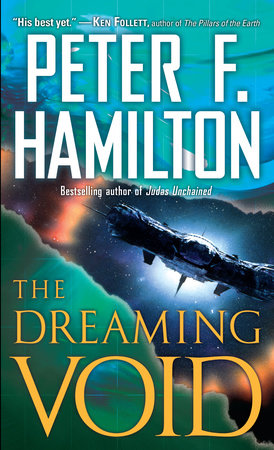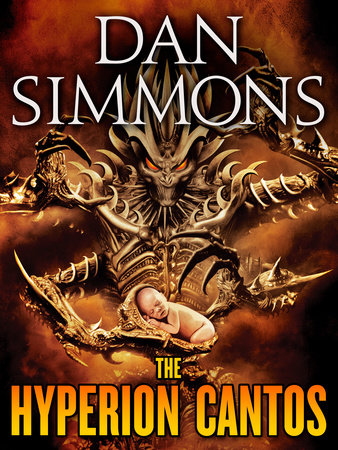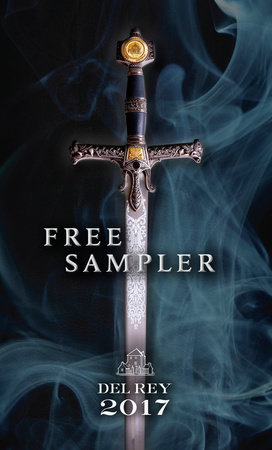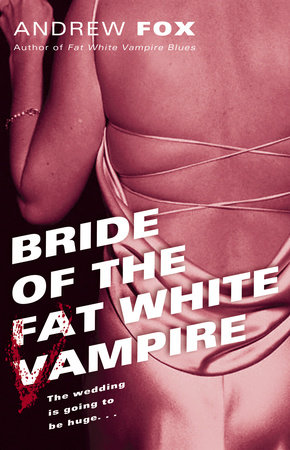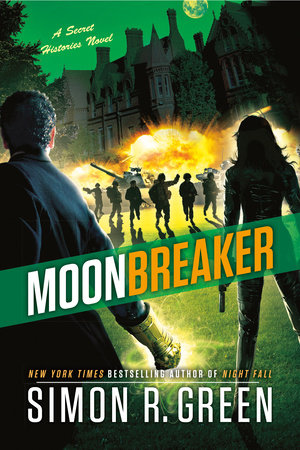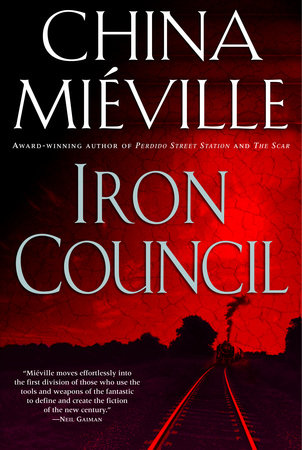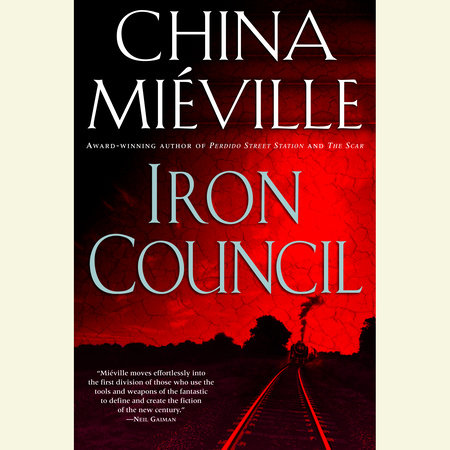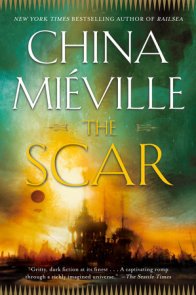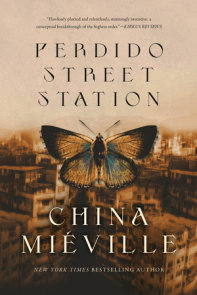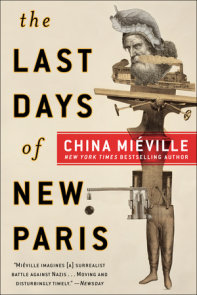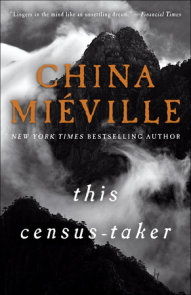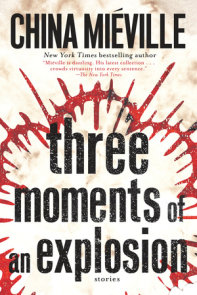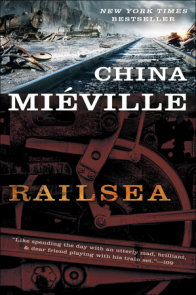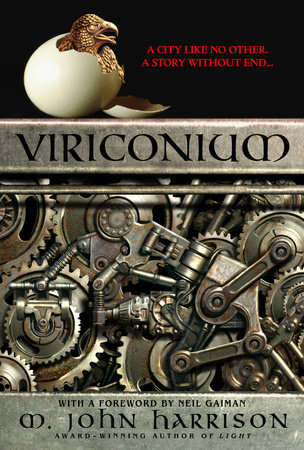Author Q&A
Del Rey: Your new novel, Iron Council, returns to the city of New Crobuzon. Where does it fit into the events that took place in your previous novels, Perdido Street Station and The Scar?
China Miéville: Iron Council takes place more than two decades after the events of the previous two books, which occurred more or less straight after each other. Several of the events of those earlier novels are alluded to, but in passing, as historical events.
DR:Do these books share more than simply a setting? In other words, are you telling a larger story, one in which each book might be thought of as a single chapter, or a facet? Are you, for instance, writing a kind of history of New Crobuzon?
CM:It’s very important to me that each of these books is a standalone–you don’t have to read them in any order; you don’t have to read all of them: each tells its own story. At the same time, though, there are references and characters and settings and events that recur, that are mentioned and then reformulated, so that it’s intended that each book will riff off the others. So if you do read all of them, particularly in order, there’ll be certain threads of continuity and implication that will come clear.
This will sound ridiculously pretentious, but I think of the three books as an anti-trilogy. They’re each standalone, but they also work to create a sort of unity. Structurally, they respond to each other: The Scar is sort of the anti-Perdido Street Station, and Iron Council is intended as a resolution to the previous two.
DR:The term “new weird” often comes up in conjunction with your work, and the work of several other new speculative fiction writers. Is it a term you embrace? What does it mean?
CM:New weird started as a provocation, but it also, to my mind, did a real and a persuasive job of pointing to a tendency–nebulous, to be sure, but I also think genuinely there, somehow–toward a kind of generic slippage and grotesquerie, combined with literary facility and moral/political complexity on the part of some recent fantastic literature. Like any label, it’s an unstable categorization, but yes, I think it was certainly more useful than it was unhelpful. The starting point for any argument about categorization has to be, do you think something is happening in the direction you’re pointing.
It seems to me that there are things going on–among writers like M. John Harrison, Steph Swainston, Liz Williams, Jon Courtenay Grimwood, Nick Mamatas, and loads of others–and that the resistance to categorization runs the risk of not letting us talk in general terms about changes of literary mood, which I do definitely think can occur. I’ve written a couple of pieces about new weird in a couple of forums, including a longish piece for the upcoming Nebula anthology, and I figure I should try to let those be my last words on the matter. Otherwise you become a self-parody very easily, always cranking out the same old shit.
DR:Who are some of your influences as a writer, and as a writer of fantasy? Do you see your work as part of a tradition in fantasy literature?
CM: The problem with any discussion of influence is that you’re not conscious of everyone who influences you. And then there’s another question, which is who are the authors you admire. Who may or may not influence you, directly or indirectly. And then who are the authors whose work you like, for whom the same applies. Four different questions, with only some shared answers.
For years, for example, I forgot to list Michael de Larrabeiti among my influences–that wasn’t because his magnificent Borrible trilogy isn’t an influence, but because it is so deep an influence I’d forgotten it. I’m happy to rectify that now.
To list just a few of those I’m conscious of being influenced by: M. John Harrison; Michael Moorcock; Dambudzo Marechera; Mervyn Peake; Philip K Dick; Charlotte Bronte; Jane Gaskell; Borges; HG Wells: Lovecraft; William Hope Hodgson; the Surrealists, particularly Benjamin Péret; Iain Sinclair; Ambrose Bierce… It gets a bit breathless, this list of names, particularly because there are ten unnamed for every one I’ve named.
I definitely see myself as writing in a tradition: more specifically, I see myself triangulating off two traditions. One is that of the Weird Tales writers like Lovecraft; the other is the New Worlds writers like Harrison and Moorcock. I’m interested in traditions that stress grotesquerie and the baroque, the surreal, radical estrangement.
DR:What are your feelings about the work and influence of Tolkien on contemporary fantasy?
CM:This is another of those areas where I’ve become a self-parody, performing the China-Doesn’t-Like-Tolkien show… My attitude to Tolkien is a matter of record. In short, I admire his neurotically precise world-creation, but I dislike his bucolic romanticisation of pre-industrialism and his moralism. He’s immeasurably better than many of his imitators, of course, but I do think his influence has become something of a bane, a barrier to invention. Thankfully I think that’s shifting.
DR:Your work also has a strong political dimension, to a degree that seems unusual in fantasies.
CM:It seems to me that all writing is political, insofar as it is “about” the time and place in which it’s written, whatever the author intends. Obviously, there are degrees of directness, and some writers work with that quite consciously, and try to do things with it, whereas others try to step aside from it.
It’s important not to think that to be “political” a piece of writing has to directly parallel or metaphorize reality in any obvious and direct way–there are plenty of bits of writing I think of as enormously political, but which are very opaque (M. John Harrison is an example). That said, I tend to express political concerns and interests in my fiction, in a none-too-disguised way. I’m politically active, and that way of looking at the world informs me very much, so of course I try to investigate it in the fiction. Questions of oppression and conflict crop up a lot in the books. What I try to do, though, is to have it that if you’re interested in those sorts of questions, you’ll find a texture and a hinterland there, but that it’s not necessary–it’s also, I hope, a ripping yarn, that keeps people turning the pages, and has some cool monsters in it. More than anything, I’m in weird fiction for the monsters.
DR:There are elements in the three New Crobuzon books that chime with our own mythology. For instance, The Scar features a vampire. You go even further in Iron Council by clearly basing one of your main characters, Judah Low, a master of golem magic, on the historical figure of Rabbi Judah Lowe of Prague, reputed by legend to have created a golem. First of all, what drew you to the figure of Rabbi Lowe? And secondly, are you implying that there is a connection, however tenuous, between the worlds of Bas-Lag and the Earth we know? If not, why make the allusion so explicit?
CM: Mostly I try to create new creatures, but I’m also interested, as with the vampire in The Scar, of taking really fairly stock monsters and trying to do something somewhat new with them. As to Iron Council, the character you’re talking about isn’t based on Yehudah Loew (his name seems to be spelled a thousand different ways!), so much as being a reference to him. The character was always going to be in the book, and was always going to be someone who used golems, and as I thought about the various myths of the golems, I thought a nod to the Rabbi would be a respectful thing to do. I’m not making any claims at all about analogies between the two–my relationship to references is more scattershot than that.
Similarly, for example, the scarab-headed race in my world, the Khepri, are a reference to the ancient Egyptian god of the same name, but where that god is a symbol of rebirth, I just thought the idea of people with beetle heads was really cool… It’s a kind of cheerful philistinism of influence.
That said, I’m not so naïve as to not know that the particulars of (say) the Prague golem story didn’t enter my head and influence me in ways I’m not conscious of: I’m just saying it’s very much not the idea that it should be read as what the book is “really” trying to express. I don’t think Judah Low is anything like Yehudah Loew, necessarily, other than the golem thing (and even that they do differently).
The worlds are connected, but only in the sense that we live in this world and we’re reading about the other one! I don’t think of it as any more direct than that; I just enjoy references. There are countless, countless references in all the books. In The Scar, for example, there are whole rosters of characters taken from other maritime literature–characters from books by William Golding, from Lewis Carroll’s The Hunting of the Snark, ship names from Jules Verne and William Hope Hodgson. If the reference is too intrusive, obviously it doesn’t work, but the aim is to make it that it doesn’t have to be got at all, but that if it is, it adds a bit of texture.
DR: You really go to town with the idea of golems in this novel! Judah turns out to be a genius in their creation and manipulation. What is it about golems that interests you? It struck me at one point that writers are a kind of golem makers, and books are language golems . . .
CM: Each of the Bas-Lag books involved me getting interested in a different way of how to conceptualize what I think of as weird science: i.e., something that would be impossible and magical in the real world, but which is rigorously and scientifically delineated in Bas-Lag. The first book has Crisis Energy, the second Possibility Mining, the third Golemetry. I was interested in golems for a whole number of reasons, one of them being the idea that they are a vivid expression of human creativity, bending matter and material to do their bidding. And also, yes, as you suggest, once you really start developing golems as a theme, you can interpret all sorts of counterintuitive things into that schema, which I enjoyed.
And, from the point of view of my grotesquophilia, the notion of ambulatory clay (and other stuff) is just very cool.
DR: How integrated in your mind are the various races and magics, even alternate histories, characteristic of Bas-Lag? Is this a fictional world where anything and everything you come up with can go, or are there certain inherent (if arbitrary) rules about what’s possible here, and what’s not, that you follow in building the world?
CM: There are definitely rules. I hate the idea of magic being a Get-Out-Of-Plot-Difficulty-Free card. I have mapped out the parameters of Bas-Lag, its races, its magic, its religions, in some detail–I leave space to develop certain ideas as they come up, and I don’t mind changing my initial conceptions so long as it doesn’t alter anything which has been printed and is “canon,” but I try to be very systematic about it.
I reserve the right for anything I think of to come up, but I also promise to try to integrate it into a consistent universe.
DR: The structure of the races and the magics of Bas-Lag at times remind me of the elaborate schemata of role-playing games. Did such games influence your development as a writer?
CM: Absolutely! I played RPGs for some years, especially Call of Cthulhu and Runequest. Although I haven’t played them for a good 18 years, I’m still very interested in them, and buy the rulebooks and bestiaries and so on fairly regularly.
What interests me about RPGs is two things: the obsessive fascination with anything fantastic; and the mania for systematization, to express things in dice terms. Sometimes this leads to real absurdities–Cthulhu, for example, in Lovecraft’s stories, is completely unthinkable … and yet here he is with all his “stats”! Strength, 300, Endurance, 200, or whatever they are. This to me is an act of absolutely heroic point-missing. But it appeals to me! I see the attraction, even if I think it can be silly.
I also like the elements of contingency and the sheer random in (some) RPGs, the move away from prophetic notions of “thus it is written”–because with one low roll, it can be unwritten. There’s been some talk of turning Bas-Lag into an RPG, which I’d certainly be interested in, even if a bit nervous of.
DR: As a British writer, have you found any striking differences between the ways your work is perceived on both sides of the Atlantic?
CM: Not as much as you might think. There are certain clichés you always hear, that certain work doesn’t succeed in the US because it’s “too British,” which is vaguely supposed to mean depressing, most of the time. I’m skeptical of that–I think of my work as enormously British (and some would say depressing, I suppose), but I’ve been blown away by my reception in the US.
I’m very lucky, because I get reviewed outside of the genre as well as inside, and I seem to have a reasonable number of readers who don’t come out of SF and fantasy, but who’ve come across my stuff in other ways. If anything, maybe more so in the US than in Britain. It would be nice and schematic to talk about huge differences in reception, but I’d be lying if I said I was very conscious of them.
DR: Let’s talk about some of your other work. Tell us about The Tain.
CM: That was a novella I put out with the small press PS Publishing, which to my delight and surprise won the Locus Award for Best Novella last year. It’s sort of a post-apocalypse story, set in a ruined London, and partially inspired by a snippet from Borges. It’s available in the collection called Cities, along with pieces by Moorcock, Geoff Ryman and Paul di Filippo. It’ll also be in my short story collection, coming out from Del Rey Books some time next year.
DR: Will you ever return to the story and characters of your first novel, King Rat?
CM: I may do. King Rat was a very different book, set in contemporary London, a dark supernatural thriller set in London’s music scene. It feels very much a completed piece, but I’m very fond of various of the characters, and I think it’s a good rule of life never to say never. Certainly there’s space for a sequel or a follow-up, even if I’ve no intention now.
DR: What other projects are you working on?
CM: I’m writing a lot of short stories at the moment, or at least trying to (I love them when they work, but they don’t come very easy). I’m also putting the finishing touches to a non-fiction book which’ll come out probably later this year (it’s for a very small market; it’s an academic book based on my PhD, about the philosophy of international law). Apart from that, I’ve started work on the research for the next novel, the first non-Bas-Lag novel for several years. It’s going to be very interesting to do something different.
DR:Will there be more books set in the world of Bas-Lag?
CM:I’m going to take a break from Bas-Lag for probably at least two books, but I fully expect and intend to come back there again. I have loads of ideas for stories set in various different parts of that world. I think and hope it’s a world I’ll be returning to again and again for the rest of my writing life. I’m proud of it and I love it.
